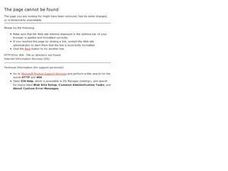Concord Consortium
Polarization
This is one cool resource for teaching about polarity! Chemistry scholars observe electron distribution and molecular shape as they select different non-metals and form bonds. The interactive offers two views, surface charge and electron...
Royal Society of Chemistry
Electronegativity Values
Finally, an electronegativity resource your class will be strangely drawn to! Skilled scientists manipulate interactive puzzles to gain an understanding of common electronegativity values. The great thing? You can conduct the lesson...
Royal Society of Chemistry
Halide Ion Tests
Young chemists love it when colorful solid products appear in a reaction vessel! Scholars discover the products that form during halide ion tests through a hands-on activity. Users go online and apply chemistry knowledge and reasoning...
Royal Society of Chemistry
Testing for Gases
If most gases are invisible, how do we know so much about them? Pupils practice associating the name, formula, testing method, and outcome for four common gases using an interactive. Users build on the content of their first puzzles to...
Concord Consortium
Stoichiometry and Balancing Equations
Is your stoichiometry lesson plan just not adding up? Incorporate an exciting interactive to balance things out! Chemistry scholars manipulate the number of molecules added to the reaction vessel, then observe as bonds form and break as...
Chymist
Testing the Waters
Should you trust the water you drink every day? The hands-on activity has scholars test water from different sources for contaminants. Pupils perform chemical testing and make conclusions about pH, hardness, iron, chlorine, lead,...
National Institute of Open Schooling
p-Block Elements and Their Compounds – II
Ozone, made of three bonded oxygen atoms, is found 15-30 km above Earth, has a strong smell, is blue, and blocks sunlight from hitting the surface of Earth. The 22nd lesson in a series of 36 specifically focuses on the important elements...
Teach Engineering
Water Remediation Lab
Water filtration — that's pure genius! Groups test the ability of a water filter to purify water by running chlorine contaminated water through a filter and measuring the chlorine concentrations as they filter the water. They then graph...
Curated OER
The Ionic Bond
An introduction to the noble gases shows how full electron shells on an atom makes an element unreactive. Your class will then develop an understanding of how sodium and chlorine react ideally because of their electron arrangement....
Curated OER
Covalent Bonding
Using chlorine as the model to demonstrate the structures and representations, this PowerPoint clearly labels and details the main atomic structures and reasons for bonding. The electrons in the outer shell are diagramed and then the...
Curated OER
Percentage Composition
In this chemistry worksheet, students find the formula weight for each of the substances listed on the sheet. Then they find the percentage composition as indicated.
Curated OER
Quantitative Problems (Mass)
In this chemistry worksheet, students identify how much aluminum and hydrochloric acid is needed to produced a certain amount of hydrogen gas. Then they identify how many grams of oxygen are used.
Curated OER
Tadpole Diary
Second graders examine the life cycle by observing tadpoles. After reading the book, Tadpole Diary, they draw the stages of tadpole development and write sentences about what they think is happening.
Curated OER
Grahams Law
In this Grahams Law worksheet, students determine which gas will escape faster when equal amounts of helium and argon are placed in a porous container and allowed to escape. Then they determine what the molecular weight of a gas is that...
Curated OER
Bonding Basics - Covalent Bonds
In this chemistry activity, students complete the chart for each of the given elements by naming the number of protons, electrons, Valence electrons, and the electrons used to fill the outer shell. Then they complete each covalent bond...
Curated OER
Compound Exercise
In this chemistry activity, learners name each of the listed compounds on the sheet. Then they compare each of the compounds to those of the periodic table.
Curated OER
Moles Worksheet
In this chemistry worksheet, students identify and write how many significant figures they would use for each problem. Then they round the answers to the appropriate number of significant figures. Finally, students calculate the mass of...
Curated OER
Balancing Symbolic Equations
In this chemistry worksheet, students balance the listed equations by changing the coefficients. They identify and explain why iron bromide can react with water to produce iron oxide and hydrogen bromide.
Curated OER
Testing the Waters
Students use test kits to measure the level of chlorine, iron, sulfide, and dissolved oxygen in tap (drinking) water and stream water. They post and evaluate the results of these water quality tests.
Curated OER
Is Your Water Clean?
Students compare water quality of different sources. They test water samples for odor, phosphates, pH, bacteria, and dissolved solids. they fill out a data table and answer questions about their findings.
Curated OER
Elements of the Periodic Table
In this chemistry worksheet, students identify and locate various vocabulary terms relating to the elements found in the periodic table. There are 116 chemistry terms located in the word search.
Curated OER
Module 9 Metals
In this chemistry worksheet, students identify and locate various vocabulary terms related to metals found in the periodic table. There are 54 chemistry terms located in the word search.
Curated OER
Chemistry Equations
For this chemistry worksheet, students balance the list of equations given using their knowledge of the Periodic table. There are 27 equations to solve on the sheet.
Curated OER
Memorization Tips: Elements/Symbols
In this chemistry worksheet, students identify ways to memorize the elements and symbols of the periodic table for chemistry. They identify phrases that use each element in a unique way.

























